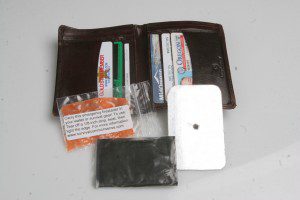(Stay or go? A fundamental precept
of urban and wilderness survival is that during or after an emergency and/or survival situation, you should stay put so rescuers can find you. But what happens if that isn’t a possibility?

What if a tornado or hurricane just happened, the emergency personnel are overwhelmed or non-existent, and you know there is no possibility of rescue?
Or suppose an accident occurs in a remote wilderness area with no potential for a rescue? What do you do in a situation where you have to rescue yourself? How do you tell the difference? How do you make the decision to stay or go?
In this article, survival expert Peter Kummerfeldt looks at the mental and physical processes of self-rescue. – Leon).
By Peter Kummerfeldt
Definition of “Self-rescue.” Getting yourself out of trouble without having to put other people at risk to rescue you.
If you work or recreate in the outdoors, sooner or later you may find yourself at the fork-in-the-road, having to decide if you should attempt to get yourself out of trouble or wait to be rescued. You should always be prepared to self-rescue and not rely on others to come to your aid. Always remember that when you call for help you are putting other people’s lives on the line!
Every life-threatening event is different and the mechanics of extracting yourself from danger will be different in each case. While the techniques used may be different, the actual process of getting yourself out of trouble is the same.
The self-rescue process involves three steps: recognizing the threat; an awareness of “certain” verses “potential” harm, and taking action to remove yourself from the life threatening circumstances.
Threat recognition: The ability to recognize threats to your life is based on the knowledge and experience acquired over a life time. The ability to recognize those situations that place you in harm’s way can also be learned from other, more experienced, people and by attending training programs that teach threat recognition.
Nowhere does the need to be able to recognize danger apply more than when you venture into the outdoors. Being able to recognize warning signs enables you to see what’s coming and then step back from the brink before the hazards threaten your life. Threats to your safety might include inclement weather, dangerous terrain, wild animal attack and many other circumstances.
 Certain verses Potential harm. Be able to differentiate between those situations that are going to affect you right now, and those that are not as immediate, but will still have to be confronted. Certain harm, for example, is finding yourself in a crashed plane that will explode when the ruptured fuel tank ignites. Or perhaps, you find yourself in an avalanche chute with a cornice above that is about to break loose. Potential harm, on the other hand, could be the onset of inclement weather later in the day or the lack of water in an arid area.
Certain verses Potential harm. Be able to differentiate between those situations that are going to affect you right now, and those that are not as immediate, but will still have to be confronted. Certain harm, for example, is finding yourself in a crashed plane that will explode when the ruptured fuel tank ignites. Or perhaps, you find yourself in an avalanche chute with a cornice above that is about to break loose. Potential harm, on the other hand, could be the onset of inclement weather later in the day or the lack of water in an arid area.
Taking Action When faced with a sudden, life-threatening situation, any immediate action in the direction of safety is better than deciding on the best action that comes too late!
John Leach, author of Survival Psychology writes: “In an emergency 75% of people have to be told what to do. Only 10-15% of the people act appropriately leaving the remaining 10-15% sitting on the sidelines acting inappropriately!” Those in the top 15% had prepared for the events that they found themselves in.
The Steps to Self-rescue
IMMEDIATE LIFE-THREAT RECOGNITION AND ACTION:
When your life’s on the line you must act immediately. You won’t have time to think. Whether you live or die depends on what you did to prepare for this moment. If you’ve never thought through what you might do “when bad things happen” you are more likely to panic and take what you hope is the best course of action. But often it isn’t.
Assuming you can extricate yourself from the event that precipitated the crisis situation, your first step is to deal with any life-threatening medical conditions. That includes your medical condition and the medical condition of any others.
Take care of yourself first. Are you bleeding severely? If so, that needs to be taken care of quickly, using first aid. Next, check the accident scene to locate other people who may need immediate help.
Is the site safe? Do you need to move to a safer area? Once you have control of the medical issues and area safety, then you can sit back and catch your breath.
DON’T PANIC
Easy to say but difficult to do!
Comedian George Carlin once commented: “We should teach people to panic because that what they are going to do in an emergency!”
There may be some truth to Carlin’s observation. But I would suggest people be taught: “The onset of panic is a normal reaction. It’s what happens the moment you realize that you’re in trouble”.
At that moment, adrenaline floods though your system putting you into a “fight-or-flight” mode. This is your body’s instinctive way of handling danger – either fight it or run away from it.
Out-of-control panic must be avoided, however. The steps you take to protect yourself from this moment on can make a huge difference in the final situation outcome. Recognize the threats to your safety and then either remove yourself from the situation or remove the threat.
As dangerous as things can become, you are seldom in a situation where you can’t take just a second or two to think before you act. But you must “act.”
Coping with a crisis depends heavily on the preparations you have made before your life is on the line. Put another
way “A person will do what they have been trained to do when they are in trouble and if they haven’t been trained they have nothing to guide them to take the correct action.”
ASSESS YOUR RESOURCES
All of the resources you are going to have to work with are those you arrive with, plus whatever you might obtain from the environment you’re in.
Despite the advice given in most survival manuals and that advice provided by such dubious survival experts as “Survivorman” and Bear Grylls of “Man verses Wild,” you should never believe you’ll be able to gather what you need.
Go through your pockets and inventory your possessions. Inventory the contents of your vehicle.
What do you have that will enable you to start a fire, erect a shelter and signal for help? Hopefully, you will have emergency equipment (survival kit) available that will enable you to do what you need to do to survive.
Evaluate the environment. Find and identify the available natural resources that you can build shelter from. Is there fuel available to build and maintain a fire? Is water available? Are there materials present with which to signal for help?
MAKE A TENTATIVE PLAN
The object is to remove yourself from the survival situation and return to your family and friends as quickly and safely as possible.
At this point, it is very important to be totally honest with yourself and develop a realistic plan with a high likelihood of success. It is very easy to allow the desire for comfort and companionship to override what may be a better decision – stay where you are.
Ego, especially with men, often gets in the way. They often grossly overestimate their ability to travel to a distant destination and also grossly underestimate the distance to that destination! Not a good combination!
Do you know where you are relative to the availability of help? What time of day is it? Is it too late to try to walk out today? Would it be better to hole-up for the night and re-evaluate the situation in the morning? Did you let someone know where you were going and when you would be back? If so, you can be assured that help will come. Be patient and allow yourself to be rescued rather than attempting to rescue yourself – it’s safer.
STEP-BY-STEP, PLAN YOUR MOVES
At least ,plan the first few moves because you might not be able to see the entire journey. Decide what you are going to do and when you are going to do it. Is your physical condition such that you can safely accomplish the overland travel you are planning? If it is, do you have the clothing you need to protect yourself from the weather conditions that exist?
Do you know where you are going? Do you have the energy that you will need to get to your destination? Do you have the navigation equipment you need to reach that destination safely? If you can answer all of these questions in the affirmative, without letting wishful thinking cloud your decision-making ability, then your next step is to:
PLAN CONTINGENCIES
Make alternative plans for foreseeable problems. Anticipate the problems that might arise as you rescue yourself. These problems may include changes in the weather, rougher terrain than you expected, heavy vegetation, overestimating your ability to negotiate the terrain you encounter and other issues. By thinking ahead, you may already have a solution to the predicaments you may face.
“DO” THE PLAN IN YOUR HEAD
. Before you start, walk through your plan step-by-step. Review each stage of the plan objectively, realistically and with an eye for anything you may have forgotten.
Ask yourself: “Can I really do this or is it my impatience and desire to be back with my family that is making me want to “get home?”
If you can’t “do” the plan in your head it won’t work on the mountain! Revise your plan. Find alternatives to those parts of the plan you have doubts about and when you are comfortable with it:
EXECUTE THE PLAN
When all is in order put your plan into action.
Do not let the concerns of others, the promises you made to be home by a certain time, the desire to go-for-help or any other issue influence your choice of action. Your decision to self-rescue should not be driven by panic or an overwhelming desire just to “get-out-of-here!
Deciding to self-rescue must be based on a thorough, comprehensive, objective review of your situation.
In the final analysis, even if it looks like you can “do-the-plan” the best choice might still be to sit tight and let the rescuers come to you!
– Peter Kummerfeldt has walked the talk in the wilderness survival field for decades. Peter grew up in Kenya, Africa and came to America in 1965 and joined the U.S. Air Force. He is a graduate of the Air Force Survival Instructor Training School and has served as an instructor at the Basic Survival School, Spokane, Washington; the Arctic Survival School, Fairbanks, Alaska, and the Jungle Survival School, Republic of the Philippines. For twelve years, Peter was the Survival Training Director at the United States Air Force Academy, Colorado Springs, Colorado. He retired from the Air Force in 1995 after 30 years of service.
East
In 1992, concerned with the number of accidents that were occurring in the outdoors annually and the number of tourists traveling overseas who were involved in unpleasant and sometimes life-threatening incidents Peter created Outdoorsafe.com He is the author of Surviving a Wilderness Emergency and has addressed over 20,000 people as the featured speaker at numerous seminars, conferences and national conventions .



- STOP: Use this exercise to reduce stress and focus your thoughts.
- Write a note to let people know where you went, before you left.
- Take your Ten Essentials on every outing.
- Dress with the right fabrics.
- Have a plan to make a tarp shelter.
- Carry lightweight, compact firestarter.
- Find the most effective fire ignition system.
- How to make charcloth, a material that can catch a spark from any source.
- Use charcloth as an effective method of catching a spark to make a fire.
- It can kill you: Hypothermia
- Hardtack: A great emergency food
[Via Survival Common Sense]
Be sure to check out:
Top 100 Items to Disappear First in an Emergency
11 Survival TV Shows Worth Watching


Leave a Reply